
Panorama of Summer Lake
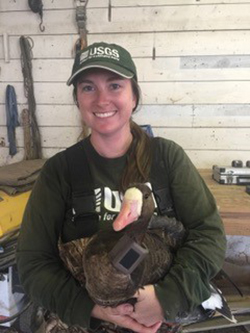
USGS employee holding goose
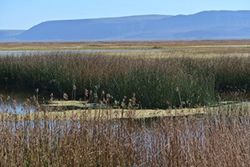
Summer Lake
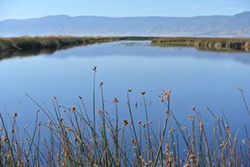
Summer Lake
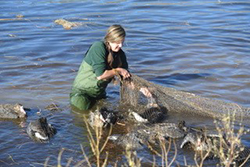
Melanie in the water retrieving geese
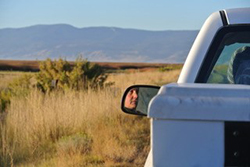
Melanie in sideview mirror
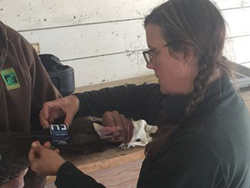
Fitting the collar
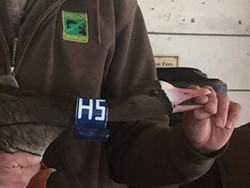
A finger nibble
Every September, California Department of Fish and Wildlife waterfowl biologist Melanie Weaver sets off on an unusual business trip. She packs up a trailer with huge nets, wire, rockets, crates and a number of VHF collars. She makes the seven-hour drive to Summer Lake, in southern Oregon’s high desert country, and settles in for a waterfowl capture project of indeterminate length. Her quarry is Anser alibifrons elgasi — the Tule white-fronted goose. Her goal is to capture, collar and release these huge, cackling birds until she runs out of collars.
Tule geese are one of two sub-species of white-fronted goose — also known colloquially as specklebelly geese, or “specs,” by hunters. The other sub-species of white-fronted goose, Pacific white-fronted, are plentiful, numbering about 700,000 in the Pacific flyway. But the Tule goose is far less common. Weaver estimates there are only 15,000 to 16,000 Tules.
Monitoring goose populations — particularly Tules — is a high priority for CDFW, as regulations are tied to the less numerous species. Currently, California regulations dictate that the hunting season for white-fronts on the west side of the Sacramento Valley closes on Dec. 21. This is to minimize harvest on Tule geese.
“They are right in the middle of a popular hunting area for Pacifics, so we have to be proactive,” Weaver explained. “If we saw the population decline significantly, we’d have to consider closing the season for all white-fronted geese. We want to avoid that.”
But why would the California Department of Fish and Wildlife be trapping geese north of the state line? One reason is logistics —Tule geese begin their southward trek from Alaska in mid-August or thereabouts. They’re heading for the Sacramento Valley, and Summer Lake Wildlife Area is a major stop over along the migration route. As they move further south into California, Tule geese mix with their more common cousins, the Pacifics. “We’ve tried to capture them in and around the Sacramento National Wildlife Refuge Complex before, and we end up expending a lot of effort just for a handful of Tules caught,” Weaver explained. “So the Oregon Department of Fish and Wildlife suggested moving our capture effort to the Summer Lake Wildlife Area. It’s largely only Tule geese coming through this time of year.”
And that’s the other reason — this partnership between the waterfowl programs from neighboring states illustrates the importance and strength of the Pacific Flyway. Alaska, Canada, Washington, Oregon and California all have a stake in ensuring the conservation of the species that traverse their lands and use their waters. ODFW doesn’t just offer up their land as a banding site. They also provide lodging for Weaver, typically split the cost of the radio collars, and supply labor for the duration of the project, no matter how long it takes.
Weaver’s ODFW counterpart, waterfowl biologist Brandon Reishus, was in it for the long haul right alongside Weaver. On a chilly Monday morning in mid-September, only just a week after they laid out the nets, they hit the jackpot. On that particular day, Reishus was crouched in the blind, using a scope to scan for incoming flocks, while Weaver sat nearby in a pickup truck. They waited and watched for a few hours, keeping in touch by radio, before Reishus spotted his opportunity. After a quick heads up to his Californian counterpart, the Oregon biologist pressed the detonation button, launching the pre-set rockets a quarter mile away. In the blink of an eye, the 60-foot-long net sailed over the unsuspecting birds as they blissfully churned up grit from the water. Both biologists then jumped into the truck and raced to the site, where they untangled the geese and put them into crates for transport to the Summer Lake Wildlife Area shop. The final count on this particular morning was 14 birds; a small number was all that was needed to complete the marking effort for this year as an earlier capture resulted in 44 birds.
The geese were given a little time to settle down before the processing began. Each bird was sexed and the bills measured. Although Weaver and Reishus can typically identify their catch just by the size and color (Tules are larger and darker than Pacifics), scientific measurements are essential for definitive identification.
The birds were also weighed before they were banded and collared. The collars will enable the biologists to obtain a population estimate on the wintering grounds, using a mark resight method. This and other data obtained from the bands will be used to make future management recommendations.
In the early afternoon, Weaver and Reishus drove back to the exact spot where the net was deployed just hours earlier. On the count of three, all the crates were opened at the same time, and the geese noisily rushed out, spreading their wings and re-forming their flock as they raced away.
As Weaver and Reishus affixed the last of the VHF collars on this particular Monday, they marveled at the unusually early conclusion of this years’ trapping effort. Sometimes it takes a full two weeks to use up their supply of collars. Once again, the team effort paid off. And even as they packed up their equipment from the Summer Lake Wildlife Area and prepared to head their separate ways, they were making plans to meet up again in a week, for a Pacific Flyway Study Committee meeting in Arizona.
“It’s such a valuable partnership,” Weaver said. “We look at the big picture, and we all work on solutions together.”
###
CDFW Photos. Top Photo: weighing a goose.